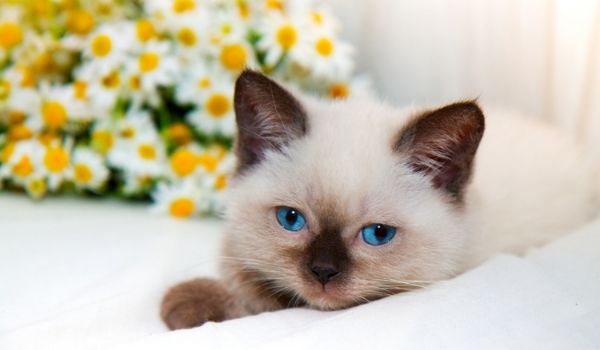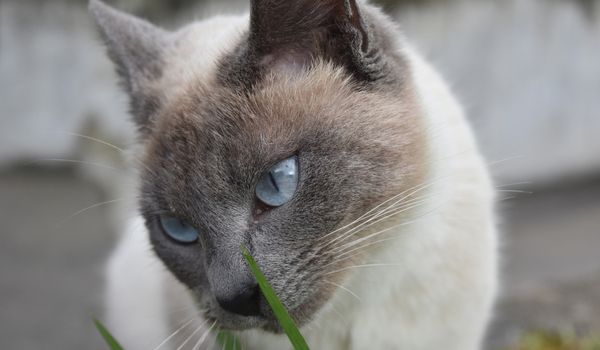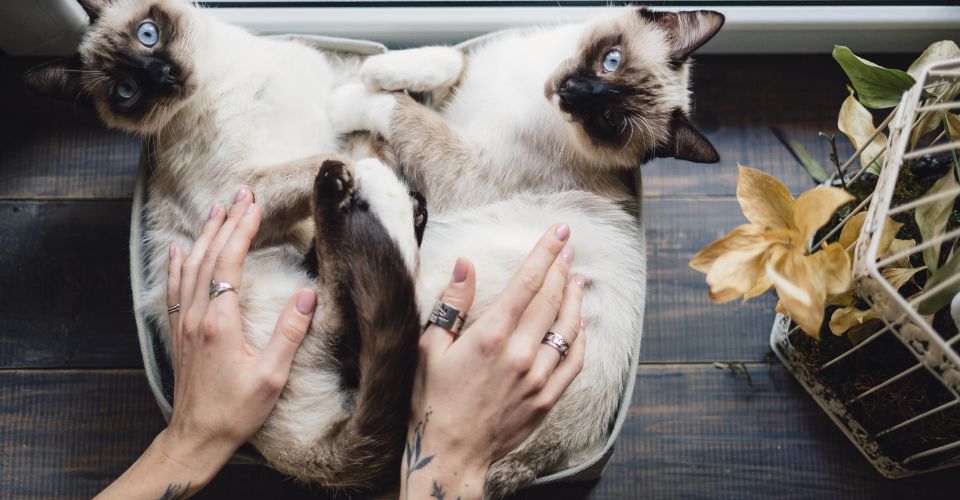Have you been thinking of adding a new cat to your family? Are you looking for a somewhat unique-looking cat that stands out at a vet clinic? Perhaps you should take a look into the Siamese cat—Blue Point Siamese cat. Blue Point Siamese cats are known for their elegant pointed coat, blue eyes, and intelligent nature. They are also known for their tendency to vocalize around their favorite persons.
Blue Point Siamese is not a separate cat breed but rather a recognized color print of the famous Siamese cat breed. Due to their pointed coat, extrovert, and playful nature, Blue Point Siamese cats have won the heart of many feline lovers—including, maybe, yours as well.
Before you go get yourself a Blue Point Siamese cat, you familiarize yourself with the breed to make sure that it would make a perfect fit for you. As far as Blue Point Siamese cats are concerned, we have got you covered.
Blue Point Siamese
Blue Point Siamese cats existed for centuries but were only recognized by The Cat Fanciers’ Association in 1934. They are medium-sized cats, weighing around 5 to 11 pounds. They have an average lifespan of 10 to 13 years. That said, if you keep your Blue Point Siamese cat with great love and care—give her the best cat treats and never miss vet visits—she may stick around for a longer time. Want to know more about Blue Point Siamese cats? Keep on reading as we dig into Blue Point Siamese cats’ personality, coat color, behavior, and much more. Before we get into details, take a quick look at the breed overview of a Blue Point Siamese cat.
Breed Overview
Weight: 5 to 11 pounds
Lifespan: 10 to 13 years
Colors: Bluish-white, cold toned fur with slate-grey-blue points
Temperament: Highly social, interactive, and intelligent cats
Suitable for: Active and outgoing cat owners
|
Energy: |
Friendly: |
||
|
Intelligence: |
Vocalization: |
||
|
Shedding: |
Lifespan: |
||
|
Sociability: |
Exercise Requirements: |
Blue Point Siamese Cat Personality
Blue Point Siamese cats are affectionate and cuddly like other Siamese cats. They are loyal and like to follow their favorite person around the house. You can also expect them to vocalize excessively when they are around their loving parents. Here, cat meowing is trying to appreciate its parents’ company and attention.
Blue Point Siamese are highly energetic cats; they would love to accompany their outgoing owners on their morning walks or weekend hikes. If you want to take them out on walks, you should get the best cat harness. You would also have to train your cat how to walk on a leash.
Since most people believe that cats cannot be trained like dogs, you may think that cat training is not a thing. But believe us when we say that cats are one of the most intelligent creatures on earth and can be trained easily, given that you know what you are doing. You can easily train your cat using a clicker and some positive reinforcements. Given that Blue Point Siamese cats are known for their intelligence, training them how to walk on a leash, or stopping cats from biting you can be easy.
If you are not an outgoing person, you will have to take some time for one-on-one interactive play sessions with your cat. You should also give your cat regualr exercise to ensure that their energy is all healthily expended—pent-up energy could make Siamese cats develop behavioral problems and sometime they might even become aggressive.

Siamese Cats Come in Three Other Officially Accepted Coat Colors
Other than the famous Blue Point Siamese, there are three other Siamese cats coat colors accepted into Cat Fanciers’ Association Siamese Breed Standard. Other famous cat associations have also recognized these coat colors in their Siamese breed standards. The three other Siamese Coat colors are:
- Seal Point Siamese
- Chocolate Point Siamese
- Lilac Point Siamese
They’re Prone to Separation Anxiety
Blue Point Siamese cats love to be in the company of their loving owners. They can easily get along with all family members, but they tend to develop a special bond with one of the family members. And when that person is not around, cats develop separation anxiety—longing for their return. With separation anxiety, you may find your cat roaming around the house, often leading to cat foaming at the mouth.
Do Blue Point Siamese Cats Make Good Family Pets?
Blue Point Siamese cats make great family pets. They get along well with children, as well as senior members of the family. They love to play with children. To make sure that your cat and kids get along well, you should teach them to respect each other’s boundaries.
Blue Point Siamese cats thrive on the attention of their loving owners. They tend to form strong bonds with their favorite persons, who allow them to lay on top of them or sleep with them in bed. The more attention you give these cats, the more they love you. But don’t be surprised if they run away from you. They want your attention but only on their terms. If they are not in the mood, they might even ignore their favorite person.
Do Blue Point Siamese Cats Get Along With Other Pets?
Like the traditional Siamese, Blue Point Siamese might not get along with any pet—cat or dog—that comes into their life at a later stage. However, if you were to introduce your Blue Point Siamese cat to another cat or dog at a young age and they grow up together, your Blue Point would easily get along with them.
Introducing a new cat or a dog to a bit older Blue Point Siamese cat could be stressful and might lead to catfights. But if you were to introduce them correctly, ensuring that no one invades your Blue Point Siamese’s personal space, they might end up getting along.
As far as little pets like hamsters and parakeets are concerned, you should never let them be around your Blue Point Siamese cats. These cats have a high prey drive and might chase these small pets. They might not hurt these pets, but the chase will be enough to give these small pets anxiety and stress.
Blue Point Siamese Cat Coat Color
Color is the most important feature of Siamese cats. Their unique coat coloration makes them one of the easily recognizable cat breeds. A Blue Point Siamese cat will have a bluish-white body and slate-blue points—her face, nose, ear, neck, paws, and tail would be darker in color. Sometimes, a Blue Point Siamese may have silvery-blue points rather than slate-blue. That said, their points will always be darker and bluer in color as compared to the pinkish-toned points in Lilac Point Siamese cats.
Blue Point Siamese Kittens
Blue Point Siamese kittens are some of the cutest kittens. Hearts of many, even not cat people, melt watching adorable Blue Point Siamese kittens. But make no mistake, these adorable cute-looking kittens are highly energetic cats and can make a huge mess if they do not get the environment they were looking for.
Blue Point Siamese Kittens are born with white coats. You must be wondering where their points come from then. Well, Siamese cats’ coat is greatly influenced by their body temperature. They have special modifier genes that determine the color of their coat. Interestingly, these modifier genes can only work to cause albinism when the cat’s body temperature is between 100 to 102.5 degrees.
Your Blue Point Siamese kitten will start changing color when the environment is cold. As the cat’s body is colder in the neck regions, ears, face, tails, and paws, its skin will be darker in these areas.
Read: Lynx Point Siamese
Things to Know Before Getting a Blue Point Siamese Kitten
Have you been thinking of getting a Blue Point Siamese cat home? Well, before you do that, you should know a few things. One, Blue Point Siamese cats make a great family pet, so congratulations! Two, Blue Point Siamese Kitten thrive on their loving parents’ attention. Bring a Blue Point Siamese cat home only if you have ample time to pet them, play with them, and give them regular exercise. Three, Blue Point Siamese cats do not like to be left alone.
Therefore, you should bring one home only if one of the family members is always going to be at home all of the time. The Blue Point Siamese cat does not make a good choice for working parents, who will have to leave their cat home alone for a considerable time every day.
Lastly, Blue Point Siamese kittens and cats love to climb up trees. So, at your home, where there are no trees, you might find your Blue Siamese cat climbing over bookshelves and doors. During this climbing, she may knock over a few things.
If you do not want your Blue Point Siamese cat to treat your home like a jungle, you should consider getting her a cat window perch or a cat tree with multiple levels.
Do Blue Point Siamese Cats Shed?
Yes, Blue Point Siamese cats shed, but when compared to other cat breeds, they shed very little. Blue Point Siamese cats have an extra-shorthaired coat that sheds very little. With weekly brushing, you can easily get rid of the dead hair in your cat coat, further reducing the shedding.
Are Blue Point Siamese Cats Hypoallergenic?
No cat can be completely hypoallergenic. That said, several cat breeds are often considered hypoallergenic as they pose little risk of triggering allergies in their owners. Because Siamese cats, including Blue Point Siamese cats, pose a minimal risk of causing allergies, Siamese are considered hypoallergenic cats.
Besides low shedding, Blue Point Siamese cats produce very little Fel D1—an allergen that is responsible for triggering allergies.
Some Interesting Facts About Blue Point Siamese Cats

Has the above discussion about Blue Siamese Cat already piqued your interest? Or do you need some interesting facts about them to be wooed once and for all? If the latter is the case, here are some interesting facts about a Blue Point Siamese.
All Blue Point Siamese Kittens Are Born White
Have you ever come across a Blue Point Siamese kitten? They look adorable. Unlike their parents and other young and adult Siamese cats, they will be all white—no dark-colored coat on their paws, ears, face, neck, nose, and tail. As discussed above, all Siamese cats, including Blue Point Siamese, have a special modifier gene that stops pigments from reaching the fur. These modifier genes only work at a higher temperature—between 100 to 102.5 degrees.
So Blue Point Siamese kittens and other Siamese kittens are born white because the mother’s womb is warm. However, after birth, as kittens’ body temperature lower, the modifier genes stop working, and kittens start to get their charming points.
Blue Point Siamese Always Have Blue Eyes
Do you love cats with blue eyes? Are you also charmed by the pointed coat of Blue Point Siamese cats? Usually, they might say that you cannot get all the features you want in a thing—there are always trade-offs. Well, no trade-offs here. You can get both pointed patterns and blue eyes in Blue Pointed Siamese cats.
Yes, you read it right. All Siamese cats, including Blue Point Siamese cats, have blue eyes.
Read: Flame Point Siamese
Blue Point Siamese Cats Are Always Pointed
Let alone Blue Point Siamese, all purebred Siamese cats are always pointed. This is because they have a unique Himalayan gene (Siamese albino gene) that causes partial albinism in Siamese cats. As discussed above, this gene cannot work in cooler temperatures. So it cannot cause albinism in cooler parts of the cat’s body, i.e., nose, ears, face, paws, and tail. Thus, a Siamese cat will always be pointed.
Siamese Cats Come in Three Other Officially Accepted Coat Colors
Other than the famous Blue Point Siamese, there are three other Siamese cats coat colors accepted into Cat Fanciers’ Association Siamese Breed Standard. Other famous cat associations have also recognized these coat colors in their Siamese breed standards. The three other Siamese Coat colors are:
- Seal Point Siamese
- Chocolate Point Siamese
- Lilac Point Siamese
Blue Point Siamese Cats Are Traced Back to Siam
Though it was only recognized by the CFA in the twentieth century, the Siamese breed has existed for centuries. It can be traced back to Siam, present-day Thailand. As Siamese cats were exported to the west, they charmed cat lovers and gradually spread across the world.
Blue Point Siamese Cats Are Prone to Separation Anxiety
Blue Point Siamese cats love to be in the company of their loving owners. They can easily get along with all family members, but they tend to develop a special bond with one of the family members. And when that person is not around, cats develop separation anxiety—longing for their return. With separation anxiety, you may find your cat roaming around the house and foaming at the mouth.





